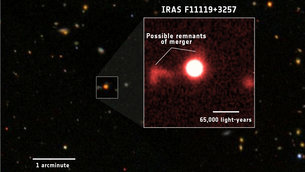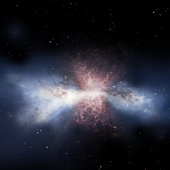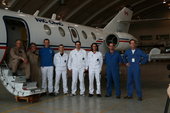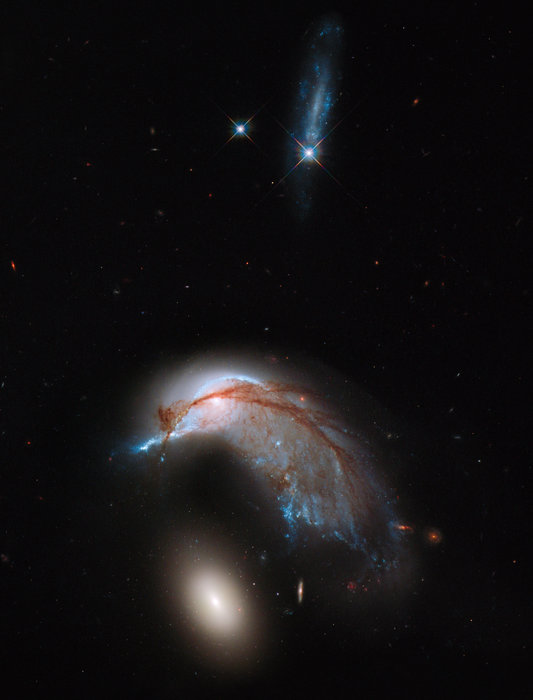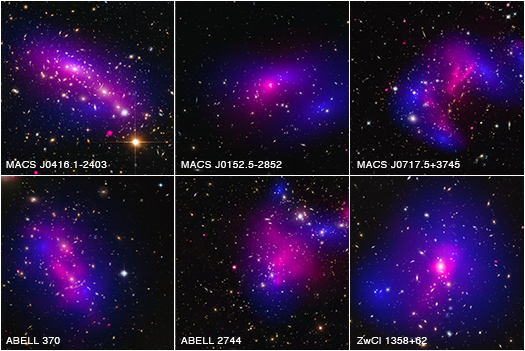 |
| Credit: X-ray: NASA/CXC/Ecole Polytechnique Federale de Lausanne, Switzerland/D.Harvey & NASA/CXC/Durham Univ/R.Massey; Optical & Lensing Map: NASA, ESA, D. Harvey (Ecole Polytechnique Federale de Lausanne, Switzerland) and R. Massey (Durham University, UK) Press Image and Caption
Using observations from NASA's Hubble Space Telescope and Chandra X-ray Observatory, astronomers have found that dark matter does not slow down when colliding with itself, meaning it interacts with itself less than previously thought. Researchers say this finding narrows down the options for what this mysterious substance might be.
Dark matter is an invisible matter that makes up most of the mass of the universe. Because dark matter does not reflect, absorb or emit light, it can only be traced indirectly by, such as measuring how it warps space through gravitational lensing, during which the light from a distant source is magnified and distorted by the gravity of dark matter.
The leading theory is dark matter is spread throughout clusters of galaxies and is frequently very close to each other. To learn more about dark matter and test such theories, researchers study it in a way similar to experiments on visible matter -- by watching what happens when it bumps into other objects. In this case, the colliding objects under observation are galaxy clusters.
Researchers used Hubble and Chandra to observe these space collisions. Specifically, Hubble was used to map the distribution of stars and dark matter after a collision, which was traced through its gravitational lensing effect on background light. Chandra was used to detect the X-ray emission from colliding gas clouds. The results are published in the March 27 edition of the journal Science.
"Dark matter is an enigma we have long sought to unravel," said John Grunsfeld, assistant administrator of NASA's Science Mission Directorate in Washington. "With the combined capabilities of these great observatories, both in extended mission, we are ever closer to understanding this cosmic phenomenon."
Galaxy clusters are made of three main ingredients: galaxies, gas clouds, and dark matter. During collisions, the gas clouds surrounding galaxies crash into each other and slow down or stop . The galaxies are much less affected by the drag from the gas and, because of the huge gaps between the stars within them, do not slow each other down.
"We know how gas and stars react to these cosmic crashes and where they emerge from the wreckage. Comparing how dark matter behaves can help us to narrow down what it actually is," said the study's lead author David Harvey of the École Polytechnique Fédérale de Lausanne (EPFL) in Switzerland.
Harvey and his team studied 72 large cluster collisions. The collisions happened at different times and were viewed from different angles -- some from the side, and others head-on.
The team found that, like the galaxies, the dark matter continued straight through the violent collisions without slowing down. This means dark matter does not interact with visible particles and flies by other dark matter with much less interaction than previously thought. Had the dark matter dragged against other dark matter, the distribution of galaxies would have shifted.
"A previous study had seen similar behavior in the Bullet Cluster," said team member Richard Massey of Durham University in the United Kingdom. "But it's difficult to interpret what you're seeing if you have just one example. Each collision takes hundreds of millions of years, so in a human lifetime we only get to see one freeze-frame from a single camera angle. Now that we have studied so many more collisions, we can start to piece together the full movie and better understand what is going on."
With this discovery, the team has successfully narrowed down the properties of dark matter. Particle physics theorists now have a smaller set of unknowns to work around when building their models.
"It is unclear how much we expect dark matter to interact with itself because dark matter already is going against everything we know," said Harvey. "We know from previous observations that it must interact with itself reasonably weakly." Dark matter may have rich and complex properties, and there are still several other types of interactions to study. These latest results rule out interactions that create a strong frictional force, causing dark matter to slow down during collisions.
People Who Read This Also Read...
The team also will study other possible interactions, such as dark matter particles bouncing off each other like billiard balls and causing dark matter particles to be ejected from the clouds by collisions or for dark matter blobs to change shape. The team also is looking to study collisions involving individual galaxies, which are much more common.
"There are still several viable candidates for dark matter, so the game is not over. But we are getting nearer to an answer," said Harvey. "These astronomically large particle colliders are finally letting us glimpse the dark world all around us, but just out of reach."
The Hubble Space Telescope is a project of international cooperation between NASA and ESA (European Space Agency). NASA's Goddard Space Flight Center in Greenbelt, Maryland, manages the telescope. The Space Telescope Science Institute (STScI) in Baltimore conducts Hubble science operations. STScI is operated for NASA by the Association of Universities for Research in Astronomy, Inc., in Washington.
NASA's Marshall Space Flight Center in Huntsville, Alabama, manages the Chandra program for NASA's Science Mission Directorate in Washington. The Smithsonian Astrophysical Observatory in Cambridge, Massachusetts, controls Chandra's science and flight operations.
An interactive image, a podcast, and a video about the findings are available at:http://chandra.si.edu For more Chandra images, multimedia and related materials, visit: http://www.nasa.gov/chandra
Media contacts:
Felicia Chou Headquarters, Washington 202-358-0257 felicia.chou@nasa.gov Ray Villard Space Telescope Science Institute, Baltimore, Md. 410-338-4514 villard@stsci.edu Megan Watzke Chandra X-ray Center, Cambridge, Mass. 617-496-7998 mwatzke@cfa.harvard.edu |
La investigación y la exploración espacial son parte indeleble de nuestro tiempo y se transformaron en una especie de pasión personal. Lo que usted podrá leer aquí es el fruto de esa combinación transformada en noticias y notas personales. Walter Farah
Monday, April 13, 2015
NASA's Hubble, Chandra Find Clues that May Help Identify Dark Matter
Etiquetas:
Chandra -ray Observatory,
dark matter,
Hubble,
NASA
Saturday, April 11, 2015
Descubiertas moléculas orgánicas complejas en un joven sistema estelar
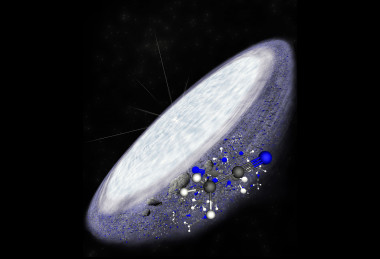 |
Tanto esta molécula como su pariente más simple, el ácido cianhídrico (HCN), fueron encontradas en los fríos confines del disco recién formado de la estrella, en una región que los astrónomos creen análoga a la del cinturón de Kuiper, el reino de los planetesimales helados y de los cometas en nuestro propio sistema solar, más allá de Neptuno.
Los cometas conservan, desde el periodo en que se formaron los planetas, la información original de la química temprana del Sistema Solar. Se cree que los cometas y los asteroides del Sistema Solar exterior enriquecieron al joven planeta Tierra con agua y moléculas orgánicas, ayudando a preparar la etapa en la que se desarrollaría la vida primigenia.
"Los estudios de cometas y asteroides muestran que la nebulosa solar que generó al Sol y los planetas era rica en agua y compuestos orgánicos complejos", señala Karin Öberg, astrónoma del Centro Harvard-Smithsonian de Astrofísica de Cambridge, Massachusetts (EE.UU.) y autora principal del nuevo artículo. "Ahora tenemos aún más evidencias de que esta misma química existe en otras partes del universo, en las regiones que podrían formar sistemas solares no muy distintos al nuestro".
Öberg señala que esto resulta especialmente interesante, dado que las moléculas que se encuentran en MWC 480 también se encuentran en concentraciones similares en los cometas del Sistema Solar. La estrella MWC 480, que tiene aproximadamente dos veces la masa del Sol, está a unos 455 años luz, en la región de formación estelar de Tauro. Su disco circundante está en las primeras etapas de desarrollo, es decir, recientemente ha empezado a condensarse a partir de una fría y oscura nebulosa de gas y polvo.
Estudios llevados a cabo con ALMA y otros telescopios han llegado a detectar signos evidentes de formación planetaria en este disco, aunque observaciones de mayor resolución podrían revelar estructuras similares a las de HL Tauri, que es de una edad similar.
Fábricas de moléculas orgánicas complejas
Desde hace un tiempo, los astrónomos saben que las oscuras y frías nubes interestelares son eficientes fábricas de moléculas orgánicas complejas, incluyendo a un grupo de moléculas conocidas como cianuros. Los cianuros y, en concreto, el cianuro de metilo, son importantes porque contienen enlaces carbono–nitrógeno: estos enlaces son esenciales para la formación de los aminoácidos, son la base para la creación de las proteínas y constituyen los componentes esenciales para la construcción de la vida.
Sin embargo, hasta ahora no estaba muy claro si estas mismas moléculas orgánicas complejas se forman y sobreviven de forma habitual en el ambiente energético de un sistema solar recién conformado, donde los choques y la radiación pueden romper fácilmente los enlaces químicos.
Los astrónomos han podido comprobar ahora que estas moléculas no sólo sobreviven, sino que prosperan. Y lo más importante: las moléculas detectadas por ALMA son mucho más abundantes que las halladas en las nubes interestelares. Esto revela a los astrónomos que los discos protoplanetarios son muy eficientes en la formación de moléculas orgánicas complejas y que son capaces de formarlas en escalas de tiempo relativamente cortas.
Dado que este sistema continúa evolucionando, los astrónomos especulan que es probable que las moléculas orgánicas, protegidas y a salvo en el interior de cometas y otros cuerpos helados, sean transportadas a entornos más enriquecedores para la vida.
"Gracias al estudio de exoplanetas, sabemos que el Sistema Solar no es el único que tiene tantos planetas o el único que cuenta con abundancia de agua", concluye Öberg. "Ahora sabemos que tampoco somos únicos en cuanto a nuestra química orgánica. Una vez más, hemos aprendido que no somos especiales. Desde el punto de vista de la vida en el universo, es una buena noticia".
Fuente: Agenciasinc.es
Fuente: Agenciasinc.es
Thursday, March 26, 2015
NASA's Opportunity Mars Rover Finishes Marathon, Clocks in at Just Over 11 Years
NASA
Etiquetas:
Eagle Crater,
Mars,
NASA,
Opportunity Mars Rover
Samantha Cristoforetti participa desde el espacio en la II Jornada Internacional de Mujer y Aeronaútica
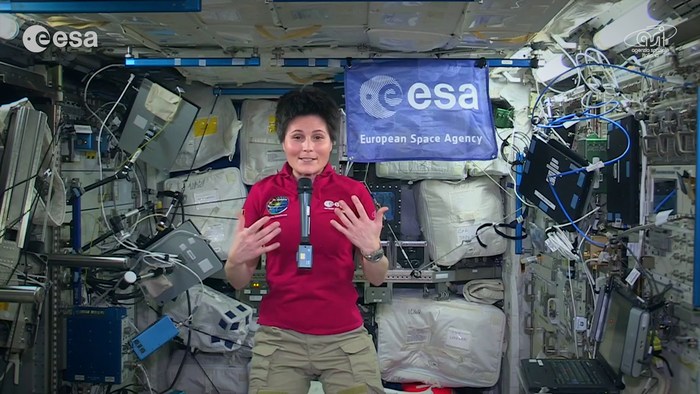 |
|
La astronauta de la ESA Samantha Cristoforetti, actualmente a bordo de la Estación Espacial Internacional, se dirigió esta mañana a las mujeres: “En Europa y en todo el mundo necesitamos que más jóvenes escojan carreras científicas y técnicas”, dijo. “Son ámbitos dónde aún necesitamos aumentar la contribución de mujeres, y espero que la exploración espacial sea fuente de inspiración para ellas, como lo ha sido para mí”. Su mensaje grabado se escuchó en la II Jornada Internacional de Mujer y Aeronáutica, celebrada esta mañana, en Madrid.
En la jornada, organizada por Fly News y Aeropress, mujeres con cargos de responsabilidad en empresas del sector aeroespacial analizaron el equilibrio de géneros actual en un sector en que el porcentaje de mujeres, en especial en puestos directivos, ha sido tradicionalmente escaso.
Maite Trujillo, Ingeniera de Sistemas de la ESA, resaltó la importancia de que mensajes como el de la astronauta de la ESA lleguen alto y claro a la sociedad. Ella escogió su carrera “porque me gustaba mucho el espacio; al escuchar esta mañana las palabras de Samantha hubiera querido ser yo, la que se encontraba en la Estación Espacial Internacional”.
Para Silvia Lazcano, responsable de Investigación y Tecnología en Airbus Operations, la situación “ha mejorado mucho” respecto a hace tres décadas, cuando ella inició la carrera. Pero Lazcano afirma también que la visibilidad y el reconocimiento social de las mujeres en este ámbito sigue siendo pobre: “Se sigue admirando mucho más a la mujer modelo que a las ingenieras. Esperaba que las cosas hubieran cambiado más rápido”.
Las demás ponentes -Mónica Martínez, presidenta de GMV; Nieves Lapeña, directora técnica en el Centro de Investigación y Desarrollo de Boeing Europa; y Andrea Iglesias, consultora en la Dirección de Sistemas de Defensa y Seguridad de Isdefe- coincidieron con ella.
“Hay sin duda margen de mejora”, dijo Mercedes Oliver, vicepresidenta de la Asociación de Ingenieros Aeronáuticos de España. Como dato, recordó que las mujeres ocupan entre el 7 y el 8 por ciento de los puestos directivos en Airbus España.
Maite Trujillo resaltó la necesidad de aplicar medidas de conciliación reales, como el disponer de horarios flexibles. También debe primar la cultura de la productividad, frente a la de la permanencia en el lugar de trabajo: “Lo importante es que hagas tu trabajo bien, y no lo harás mejor por estar más horas”.
Desde la ESA se sigue una política de igualdad de oportunidades con el propósito de incrementar la presencia de mujeres, particularmente en los campos de ingeniería y científicos y en cargos de responsabilidad. La ESA defiende la conciliación familiar y laboral y ha llevado a cabo un gran número de iniciativas, cómo trabajo a tiempo parcial o flexibilidad en el horario, entre otras.
Fuente. ESA es
El Viento de los Agujeros Negros puede detener la Formación de Estrellas
 |
| El viento de un agujero negro arrastra el gas de una galaxia |
Gracias al observatorio espacial Herschel de la ESA, los astrónomos han descubierto que el viento generado por un agujero negro está barriendo la galaxia en la que se encuentra, llevándose consigo la materia prima necesaria para formar nuevas estrellas.
Los agujeros negros supermasivos se encuentran en el centro de la mayoría de las galaxias, y son objetos extremadamente densos y compactos cuya masa puede ser millones o miles de millones de veces superior a la de nuestro Sol.
Muchos de ellos, como el que ocupa el centro de nuestra Vía Láctea, son relativamente pasivos, pero otros están destruyendo su entorno con gran voracidad.
Los agujeros negros no sólo engullen el gas que los rodea; a veces también lo expulsan en forma de potentes chorros o vientos. Los astrónomos sospechaban desde hace tiempo que estos escapes de materia podrían ser los responsables de vaciar a las galaxias de gas interestelar, y en particular de las moléculas a partir de las que se forman las nuevas estrellas.
Con el paso del tiempo estos vientos acabarían afectando a la actividad de formación de estrellas en la galaxia, pudiendo llegar a detenerla por completo.
Sin embargo, hasta la fecha no se había logrado estudiar este proceso. Los astrónomos habían detectado fuertes vientos en las inmediaciones de los agujeros negros gracias a los telescopios de rayos X, y habían descubierto escapes de gas a gran escala a través de las observaciones en el infrarrojo, pero nunca habían observado estos dos fenómenos en una misma galaxia.
Un nuevo estudio acaba de cambiar el panorama, al lograr observar los vientos a pequeña y a gran escala desencadenados por un mismo agujero negro.
“Es la primera vez que vemos un agujero negro supermasivo en acción, barriendo los depósitos de gas de su galaxia”, explica Francesco Tombesi, del Centro Goddard de la NASA y de la Universidad de Maryland, Estados Unidos, quien dirigió la investigación publicada ayer en la revista Nature.
Al combinar las observaciones realizadas por el satélite europeo Herschel en las longitudes de onda del infrarrojo con los nuevos datos en la banda de los rayos X recogidos por el satélite japonés-americano Suzaku, los astrónomos han sido capaces de comparar los vientos en las inmediaciones del agujero negro central con sus efectos a gran escala, arrastrando las reservas de gas de la galaxia IRAS F11119+3257.
Los vientos empiezan siendo locales y fuertes, con ráfagas que alcanzan el 25% de la velocidad de la luz y que son capaces de arrastrar una masa solar de gas al año.
A medida que se alejan del agujero negro central los vientos se frenan, pero consiguen empujar fuera de la galaxia una cantidad de gas equivalente a cien veces la masa de nuestro Sol.
Esta es la primera prueba firme de que los vientos provocados por un agujero negro pueden despojar a una galaxia de gas, a través de escapes a gran escala.
Este descubrimiento refuerza la teoría de que los agujeros negros podrían llegar a detener el proceso de formación de estrellas en la galaxia en la que se encuentran.
“Herschel ha revolucionado las teorías sobre la formación de las estrellas. Estos nuevos resultados nos ayudan a comprender cómo y por qué varía la actividad de formación de estrellas en algunas galaxias, pudiendo llegar a detenerse por completo”, explica Göran Pilbratt, científico del proyecto Herschel para la ESA.
“Hemos encontrado al culpable de este gran misterio cósmico. Como muchos sospechaban, un agujero negro central puede desencadenar escapes de gas a gran escala, deteniendo la actividad de formación de estrellas”.
Más información
“Wind from the black-hole accretion disk driving a molecular outflow in an active galaxy,” de F. Tombesi, et al, ha sido publicado en la edición del 26 de marzo de 2015 de la revista Nature.
Este estudio está basado en las observaciones realizadas con el instrumento PACS (Photoconductor Array Camera and Spectrometer) del observatorio espacial Herschel de la ESA, y en los datos recogidos por la misión japonesa-estadounidense Suzaku.
Para más información:
Markus Bauer
ESA Science and Robotic Exploration Communication Officer
Tel: +31 71 565 6799; +34 91 8131 199
Mob: +31 61 594 3954
Email: markus.bauer@esa.int
ESA Science and Robotic Exploration Communication Officer
Tel: +31 71 565 6799; +34 91 8131 199
Mob: +31 61 594 3954
Email: markus.bauer@esa.int
Francesco Tombesi
X-ray Astrophysics Laboratory
NASA Goddard Space Flight Center
Greenbelt, MD, USA
and Department of Astronomy and CRESST
University of Maryland, MD, USA
Tel: +1 301 405 3615 / +1 301 286 2661
Email: ftombesi@astro.umd.edu
X-ray Astrophysics Laboratory
NASA Goddard Space Flight Center
Greenbelt, MD, USA
and Department of Astronomy and CRESST
University of Maryland, MD, USA
Tel: +1 301 405 3615 / +1 301 286 2661
Email: ftombesi@astro.umd.edu
Göran Pilbratt
Herschel Project Scientist
Tel: +31 71 565 3621
Email: gpilbratt@cosmos.esa.int
Herschel Project Scientist
Tel: +31 71 565 3621
Email: gpilbratt@cosmos.esa.int
Fuente: Esaes
Etiquetas:
agujero negro,
agujero negro supermasivo,
ESA,
estrellas,
formación de estrellas,
galaxia,
gas,
Herschel
Wednesday, March 25, 2015
Powers of Ten
Powers of Ten takes us on an adventure in magnitudes. Starting at a picnic by the lakeside in Chicago, this famous film transports us to the outer edges of the universe. Every ten seconds we view the starting point from ten times farther out until our own galaxy is visible only a s a speck of light among many others. Returning to Earth with breathtaking speed, we move inward- into the hand of the sleeping picnicker- with ten times more magnification every ten seconds. Our journey ends inside a proton of a carbon atom within a DNA molecule in a white blood cell. POWERS OF TEN © 1977 EAMES OFFICE LLC (Available at www.eamesoffice.com)
Source: Charles and Ray Eames
Video Credit & Copyright: Charles & Ray Eames (Eames Office)
How different does the universe look on small, medium, and large scales? The most famous short science film of its generation gives breathtaking comparisons. That film, Powers of Ten, originally created in the 1960s, has now been officially posted to YouTube and embedded above. Please click the above arrow to see the nine minute movie for yourself. From a picnic blanket near Chicagoout past the Virgo Cluster of Galaxies, every ten seconds the film zooms out to show a square a factor of ten times larger on each side. The video then reverses, zooming back in a factor of ten every two seconds and ends up inside a single proton. The Powers of Ten sequence is actually based on the book Cosmic View by Kees Boeke in 1957, as is a similar but mostly animated film Cosmic Zoom that was also created in the late 1960s. The changing perspectives are so enthralling and educational that sections have been recreated using more modern computerized techniques, including the first few minutes of the movie Contact, and in a short digital video called The Known Universe created in 2010 for the American Museum of Natural History. Ray and husband Charles Eames, the film's creators, were known as quite visionary spirits and even invented their own popular chair. Source
Tuesday, March 24, 2015
Curiosity encuentra nitrógeno en el suelo de Marte
En la atmósfera marciana se había detectado nitrógeno, pero por primera vez el rover Curiosity ha encontrado nitratos en la superficie del planeta rojo. Lo ha hecho tanto en muestras de polvo superficial como en materiales excavados en los sedimentos del antiguo lago del cráter Gale, por donde circula hoy el vehículo.
"Nunca antes se habían identificado compuestos de nitrógeno en la superficie de Marte, ni in situ a través derovers o landers, ni con orbitadores; tan sólo había aparecido en algunos meteoritos marcianos”, destaca a Sinc el investigador Alberto G. Fairen del Centro de Astrobiología (INTA-CSIC) y coautor del trabajo.
El investigador subraya que el equipo del instrumento SAM de rover, con el que se han efectuado los análisis, ha sido muy riguroso a la hora de cuantificar y descartar las posibles contaminaciones con nitrógeno terrestre.
En el estudio, publicado en PNAS, se detalla que los niveles de concentración de nitrógeno marciano están entre 20-250 nanomoles (nmol) tomados de muestras recogidas en tres puntos del recorrido del rover. Se han encontrado en forma de óxido nítrico o monóxido de nitrógeno (NO).
Los investigadores, que piensan que el óxido nítrico también podría hallarse en el subsuelo, sugieren que estos compuestos pudieron quedar fijados debido al choque térmico provocado por un relámpago o un impacto volcánico en el antiguo Marte. Esto supondría que, en el pasado, existió algún tipo de ciclo de nitrógeno en el plaenta rojo.
Según explica Fairen, “la existencia de una fuente de nitrógeno bioquímicamente accesible en Marte parece un requisito fundamental para la posible habitabilidad del planeta”. De hecho, “en la Tierra, el nitrógeno es uno de los elementos químicos esenciales para la vida y el nitrato es una fuente bioquímicamente accesible de N para los seres vivos en nuestro planeta”, concluye.
En este estudio también han participado los investigadores Javier Martín-Torres y Maria Paz Zorzano del Instituto Andaluz de Ciencias de la Tierra (CSIC-Universidad de Granada).
Referencias bibliográficas:
Jennifer C. Stern et al.: “Evidence for indigenous nitrogen in sedimentary and aeolian deposits from the Curiosity rover investigations at Gale crater, Mars”. Gary M. King et al.: “Carbon monoxide as a metabolic energy source for extremely halophilic microbes: Implications for microbial activity in Mars regolith”.Proceedings of the National Academy of Sciences of the United States of America, 23 de marzo de 2015.
Zona geográfica: España
Fuente: SINC a través de agenciasinces
Etiquetas:
Cráter Gale,
Curiosity,
Mars,
Marte,
nitrato,
nitrogen,
nitrógeno,
SAM,
Sample Analysis at Mars,
Sample Analysis at Mars (SAM)
Experiment Provides the Best Look Yet at 'Warm Dense Matter' at Cores of Giant Planets
In an experiment at the Department of Energy's SLAC National Accelerator Laboratory, scientists precisely measured the temperature and structure of aluminum as it transitions into a superhot, highly compressed concoction known as “warm dense matter.”
Warm dense matter is the stuff believed to be at the cores of giant gas planets in our solar system and some of the newly observed “exoplanets” that orbit distant suns, which can be many times more massive than Jupiter. Their otherworldly properties, which stretch our understanding of planetary formation, have excited new interest in studies of this exotic state of matter.
The results of the SLAC study, published March 23 in Nature Photonics, could also lead to a greater understanding of how to produce and control nuclear fusion, which scientists hope to harness as a new source of energy.
“The heating and compression of warm dense matter has never been measured before in a laboratory with such precise timing,” says Siegfried Glenzer, a distinguished staff scientist who is part of the Stanford Institute for Materials and Energy Sciences (SIMES) at SLAC. “We have shown the detailed steps of how a solid hit by powerful lasers becomes a compressed solid and a dense plasma at the same time. This is a step on the path toward creating fusion in the lab.”
This video describes how scientists at SLAC created and precisely measured the temperature and compression in "warm dense matter," an exotic state that is believed to exist at the core of giant planets like Jupiter. (SLAC National Accelerator Laboratory)
A team led by Glenzer used laser light to compress ultrathin aluminum foil samples to a pressure more than 4,500 times higher than the deepest ocean depths and superheat it to 20,000 kelvins – about four times hotter than the surface of the sun. SLAC’s Linac Coherent Light Source X-ray laser, a DOE Office of Science User Facility, then precisely measured the foil’s properties as it transformed into warm dense matter and then into a plasma – a very hot gas of electrons and supercharged atoms.
Warm dense matter remains largely mysterious because it is difficult to create and study in a laboratory, can exhibit properties of several types of matter and occupies a middle ground between solid and plasma. Our own sun is an example of a self-sustaining plasma, and plasmas have also been harnessed in some TV displays.
While warm dense matter is believed to exist in a stable state at the heart of giant planets, in a laboratory it lasts just billionths of a second. Scientists have relied largely on computer simulations, driven by scientific theories, to help explain how a solid, when shocked with powerful lasers, transforms into a plasma.
LCLS, with its complement of high-power lasers, is uniquely suited to creating and studying matter at the extremes. Its ultrabright X-ray pulses are measured in femtoseconds, or quadrillionths of a second, so it works like an ultra-high-speed X-ray camera to illuminate and record the properties of the most fleeting phenomena in atomic-scale detail.
In this experiment, researchers used a high-power optical laser at LCLS's Matter in Extreme Conditions experimental station to fire separate beams of green laser light simultaneously at both sides of coated, ultrathin aluminum foil samples, each just half the width of an average human hair. The lasers produced shock waves in the material that converged to create extreme temperatures and pressures.
Researchers struck the samples with X-rays just nanoseconds later, and varied the arrival time of the X-rays to essentially make a series of snapshots of warm dense matter formation. The team used a technique known as small angle X-ray scattering to measure the internal structure of the material, capturing its brief transition into the warm dense state.
“This early work with aluminum is a first stepping stone toward other problems we really need to solve,” Glenzer said, such as how hydrogen behaves under similar conditions. Hydrogen, which makes up about 75 percent of the visible mass of the universe, plays a central role in fusion, the process that powers stars. A better understanding of how hydrogen transitions into warm dense matter could help settle debates over conflicting theories on this transition and help unlock the secrets of fusion energy.
“I think LCLS can help to resolve the hydrogen ‘controversy,’ in upcoming experiments,” Glenzer said.
Participants in the research included scientists at SLAC, University of California Berkeley, Lawrence Livermore National Laboratory and General Atomics; QuantumWise A/S in Denmark; AWE plc, University of Warwick and University of Oxford in the U.K.; and the Max Planck Institute for the Physics of Complex Systems, Institute for Optics and Quantum Electronics, Friedrich-Schiller-University and GSI Helmholtz Center for Heavy Ion Research in Germany.
The work was supported by the DOE Office of Science, Fusion Energy Science; the DOE Office of Basic Energy Sciences, Materials Sciences and Engineering Division; Lawrence Livermore National Laboratory; a Laboratory Directed Research and Development grant; and the Peter-Paul-Ewald Fellowship of the VolkswagenStiftung.
Note: SLAC will broadcast a live webcast of a related talk by Siegfried Glenzer, "Jupiter in a Bottle: Extreme States of Matter in the Laboratory," from 7:30 p.m. to 8:30 p.m. Pacific Time on Tuesday, March 24 (more info).
For questions or comments, contact the SLAC Office of Communications at communications@slac.stanford.edu.
SLAC is a multi-program laboratory exploring frontier questions in photon science, astrophysics, particle physics and accelerator research. Located in Menlo Park, Calif., SLAC is operated by Stanford University for the U.S. Department of Energy's Office of Science.
SLAC National Accelerator Laboratory is supported by the Office of Science of the U.S. Department of Energy. The Office of Science is the single largest supporter of basic research in the physical sciences in the United States, and is working to address some of the most pressing challenges of our time. For more information, please visit science.energy.gov.
Source: SLAC 03/25/2015
Curiosity Rover Finds Biologically Useful Nitrogen on Mars
A team using the Sample Analysis at Mars (SAM) instrument suite aboard NASA's Curiosity rover has made the first detection of nitrogen on the surface of Mars from release during heating of Martian sediments.
The nitrogen was detected in the form of nitric oxide, and could be released from the breakdown of nitrates during heating. Nitrates are a class of molecules that contain nitrogen in a form that can be used by living organisms. The discovery adds to the evidence that ancient Mars was habitable for life.
Nitrogen is essential for all known forms of life, since it is used in the building blocks of larger molecules like DNA and RNA, which encode the genetic instructions for life, and proteins, which are used to build structures like hair and nails, and to speed up or regulate chemical reactions.
However, on Earth and Mars, atmospheric nitrogen is locked up as nitrogen gas (N2) - two atoms of nitrogen bound together so strongly that they do not react easily with other molecules. The nitrogen atoms have to be separated or "fixed" so they can participate in the chemical reactions needed for life. On Earth, certain organisms are capable of fixing atmospheric nitrogen and this process is critical for metabolic activity. However, smaller amounts of nitrogen are also fixed by energetic events like lightning strikes.
Nitrate (NO3) - a nitrogen atom bound to three oxygen atoms - is a source of fixed nitrogen. A nitrate molecule can join with various other atoms and molecules; this class of molecules is known as nitrates.
There is no evidence to suggest that the fixed nitrogen molecules found by the team were created by life. The surface of Mars is inhospitable for known forms of life. Instead, the team thinks the nitrates are ancient, and likely came from non-biological processes like meteorite impacts and lightning in Mars' distant past.
Features resembling dry riverbeds and the discovery of minerals that form only in the presence of liquid water suggest that Mars was more hospitable in the remote past. The Curiosity team has found evidence that other ingredients needed for life, such as liquid water and organic matter, were present on Mars at the Curiosity site in Gale Crater billions of years ago.
"Finding a biochemically accessible form of nitrogen is more support for the ancient Martian environment at Gale Crater being habitable," said Jennifer Stern of NASA's Goddard Space Flight Center in Greenbelt, Maryland. Stern is lead author of a paper on this research published online in the Proceedings of the National Academy of Science March 23.
The team found evidence for nitrates in scooped samples of windblown sand and dust at the "Rocknest" site, and in samples drilled from mudstone at the "John Klein" and "Cumberland" drill sites in Yellowknife Bay. Since the Rocknest sample is a combination of dust blown in from distant regions on Mars and more locally sourced materials, the nitrates are likely to be widespread across Mars, according to Stern. The results support the equivalent of up to 1,100 parts per million nitrates in the Martian soil from the drill sites. The team thinks the mudstone at Yellowknife Bay formed from sediment deposited at the bottom of a lake. Previously the rover team described the evidence for an ancient, habitable environment there: fresh water, key chemical elements required by life, such as carbon, and potential energy sources to drive metabolism in simple organisms.
The samples were first heated to release molecules bound to the Martian soil, then portions of the gases released were diverted to the SAM instruments for analysis. Various nitrogen-bearing compounds were identified with two instruments: a mass spectrometer, which uses electric fields to identify molecules by their signature masses, and a gas chromatograph, which separates molecules based on the time they take to travel through a small glass capillary tube -- certain molecules interact with the sides of the tube more readily and thus travel more slowly.
Along with other nitrogen compounds, the instruments detected nitric oxide (NO -- one atom of nitrogen bound to an oxygen atom) in samples from all three sites. Since nitrate is a nitrogen atom bound to three oxygen atoms, the team thinks most of the NO likely came from nitrate which decomposed as the samples were heated for analysis. Certain compounds in the SAM instrument can also release nitrogen as samples are heated; however, the amount of NO found is more than twice what could be produced by SAM in the most extreme and unrealistic scenario, according to Stern. This leads the team to think that nitrates really are present on Mars, and the abundance estimates reported have been adjusted to reflect this potential additional source.
"Scientists have long thought that nitrates would be produced on Mars from the energy released in meteorite impacts, and the amounts we found agree well with estimates from this process," said Stern.
The SAM instrument suite was built at NASA Goddard with significant elements provided by industry, university, and national and international NASA partners. NASA's Mars Science Laboratory Project is using Curiosity to assess ancient habitable environments and major changes in Martian environmental conditions. NASA's Jet Propulsion Laboratory in Pasadena, California, a division of the California Institute of Technology, built the rover and manages the project for NASA's Science Mission Directorate in Washington. The NASA Mars Exploration Program and Goddard Space Flight Center provided support for the development and operation of SAM. SAM-Gas Chromatograph was supported by funds from the French Space Agency (CNES). Data from these SAM experiments are archived in the Planetary Data System (pds.nasa.gov).
For more information about Curiosity, visit:
and
Media Contact
Nancy Neal-Jones / William SteigerwaldNASA Goddard Space Flight Center, Greenbelt, Maryland
Nancy.N.Jones@nasa.gov / William.A.Steigerwald@nasa.gov
301-286-0039 / 301-286-5017
Guy Webster
Jet Propulsion Laboratory, Pasadena, Calif.
818-354-6278
guy.webster@jpl.nasa.gov
Dwayne Brown
NASA Headquarters, Washington
202-358-1726
dwayne.c.brown@nasa.gov
2015-096
Source: JPL
Etiquetas:
biologically,
Curiosity,
Mars,
nitrogen,
SAM,
Sample Analysis at Mars,
Sample Analysis at Mars (SAM)
Monday, March 23, 2015
¿Quieres atrapar un satélite? Prueba con una red
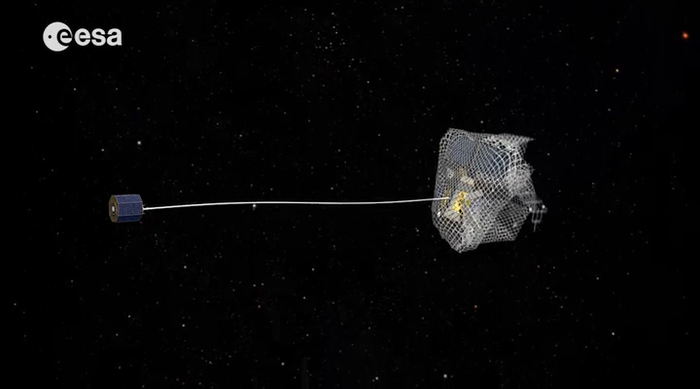 |
|
Una de las tecnologías más antiguas de la humanidad, la modesta red de pesca, podría encontrar una nueva aplicación en el espacio: retirar satélites abandonados. El comportamiento de las redes en microgravedad y su capacidad para capturar satélites acaban de ser puestos a prueba en un avión que describe arcos parabólicos para crear breves periodos de microgravedad. “Lanzamos redes desplegables con un sistema de aire comprimido hacia una maqueta a escala de un satélite”, explica el ingeniero de la ESA Kjetil Wormnes.
“Durante esta campaña, de dos días de duración, logramos lanzar con éxito 20 redes a distintas velocidades durante las 21 parábolas de microgravedad. Las redes iban dobladas dentro de cajas de papel, y tenían pequeñas masas en cada esquina para facilitar la captura del satélite”.
“Las buenas noticias es que el sistema funcionó muy bien, tanto que tuvimos que utilizar un cuchillo para liberar la maqueta y prepararla para un nuevo ensayo”.
El avión, un Falcon 20, sigue una serie de ciclos durante los que permanece 20 segundos en caída libre, sujeto sólo a la fuerza de la gravedad – lo que cancela los efectos de esta aceleración en el interior de la aeronave.
“Grabamos todas las pruebas con cuatro cámaras HD de alta velocidad”, añade Kjetil. “El objetivo era validar una herramienta de simulación que acabamos de desarrollar para diseñar las redes que harían falta en una misión real para retirar fragmentos de basura espacial de forma activa”.
Las redes fueron pintadas de varios colores para poder estudiar su comportamiento al analizar los videos de su despliegue. Se utilizaron dos materiales diferentes, y las redes de hilo, más ligeras, resultaron ser más eficaces que las de tejido.
La misión e.DeOrbit de la ESA, cuyo lanzamiento está previsto para el año 2021, estudiará la viabilidad de retirar de la órbita terrestre un gran fragmento de basura espacial – como un satélite abandonado o la etapa superior de un lanzador – para controlar la población de fragmentos de basura espacial en órbitas con alta densidad de tráfico.
Todavía se está evaluando cuál sería la mejor forma de atrapar un satélite descontrolado, que probablemente también estaría girando a gran velocidad. La iniciativa CleanSpace de la ESA – creada con el objetivo de reducir el impacto de las actividades de la industria espacial en el medioambiente espacial y terrestre – está supervisando una serie de estudios que utilizan distintas técnicas para atrapar los fragmentos de basura espacial, desde un brazo robótico o un arpón, a un haz de iones.
La red de pesca más antigua que se conoce fue encontrada por un granjero finlandés en 1913. La técnica del carbono estimó que tenía más de 10.300 años de antigüedad, lo que significaría que la red se inventó miles de años antes que la rueda.
“La principal ventaja de utilizar una red – ya sea para e.DeOrbit o para otras misiones de retirada de basura espacial – es que se puede adaptar a una gran variedad de objetivos”, explica Kjetil.
La campaña de vuelos parabólicos del Consejo Nacional para la Investigación (NRC) de Canadá fue contratada por la compañía polaca SKA Polska, encargada de realizar este estudio para la ESA.
Este equipo de investigación también está formado por la empresa italiana STAM y la polaca OptiNav.
Source: ESA Int.
Source: ESA Int.
Etiquetas:
basura orbital,
Clean Space,
Consejo Nacional para la Investigación NRC Canada,
e.DeOrbit,
ESA,
microgravedad,
OptiNav,
STAM
¿Marsopa o Pingüino?
23 marzo 2015 ¿Qué ves en esta fotografía tomada por el Telescopio Espacial NASA/ESA Hubble: una marsopa o un pingüino? Los astrónomos aficionados utilizan el nombre de cualquiera de estas dos criaturas para referirse a esta hermosa pareja de galaxias. La estructura de tonos azules y rojos que ocupa la mitad inferior de la imagen presenta una curvatura que recuerda a las elegantes formas de un delfín o de una marsopa, y si también se tiene en cuenta el pálido orbe que brilla a su lado, la pareja guarda una sorprendente similitud con un pájaro o un pingüino cuidando un huevo.
El ‘cuerpo’ del pingüino es una única galaxia, retorcida, distorsionada y hecha añicos. Esta estructura, conocida como NGC 2936, fue en su día una galaxia espiral como nuestra Vía Láctea, hasta que sus brazos terminaron desgarrados para formar la amalgama de rayos azules, gas brillante y mechas de materia roja que se pueden ver en esta fotografía. Lo que en su día fue el brillante bulbo de la galaxia ahora forma el ‘ojo’ del pingüino.
Esta galaxia ha sido deformada por la interacción con su vecina con forma de huevo, la galaxia elíptica NGC 2937. Juntas forman un par conocido como Arp 142. NGC 2937 puede parecer diminuta en comparación con NGC 2936, pero su influencia gravitatoria es muy fuerte. Estas dos galaxias se están deformando mutuamente, alterando sus respectivas formas y perturbando las estrellas, el polvo y el gas que contienen. En unos mil millones de años se acabarán uniendo para formar una única galaxia, poniendo fin al proceso de fusión que podemos observar hoy en día en todo su esplendor.
Cerca de la parte superior de la imagen se pude ver una estrella muy brillante con una estela azul, pero no es más que otra ilusión óptica. La estrella está mucho más cerca de la cámara que la mancha de color azul, que se corresponde con una galaxia mucho más lejana.
Esta imagen combina las observaciones en las bandas de la luz visible e infrarroja de la Cámara de Gran Angular 3, y fue publicada por primera vez en junio de 2013.
Source: ESA Int
Etiquetas:
estrellas,
galaxia,
NGC 2936,
NGC 2937,
Telescopio Espacial Hubble
Friday, March 20, 2015
A Black Hole Visits Baltimore
Publicado el 20/11/2014
A scientific visualization of a black hole passing through Baltimore's Inner Harbor.
This scientific visualization demonstrates the visual distortion known as gravitational lensing. A black hole, with roughly the mass of the planet Saturn, is imagined to pass over the Inner Harbor in Baltimore, MD. The view of the buildings on the far side of the harbor are distorted using the calculated effects of Einstein's general relativity.
A black hole warps the space around it. Light that passes near a black hole will follow curved paths and can create multiple images and other visual artifacts. Note that the sky can sometimes be seen by looking below the black hole. These distortions are similar to what can be produced using glass lenses, and are produced by similar optics equations. The effects are called gravitational lensing - lensing that redirects light using mass instead of glass.
The calculations for the visualization use a planar approximation that assumes the buildings are all at the same distance, but are otherwise accurate. Note also that foreground objects, like the boat mast, were not isolated and removed from the image before distortion. In a fully accurate visualization, foreground objects would not be distorted.
For more information or to download this video, visit: http://hubblesite.org/videos/video_de...
For more videos, visit: http://hubblesite.org/videos/
This scientific visualization demonstrates the visual distortion known as gravitational lensing. A black hole, with roughly the mass of the planet Saturn, is imagined to pass over the Inner Harbor in Baltimore, MD. The view of the buildings on the far side of the harbor are distorted using the calculated effects of Einstein's general relativity.
A black hole warps the space around it. Light that passes near a black hole will follow curved paths and can create multiple images and other visual artifacts. Note that the sky can sometimes be seen by looking below the black hole. These distortions are similar to what can be produced using glass lenses, and are produced by similar optics equations. The effects are called gravitational lensing - lensing that redirects light using mass instead of glass.
The calculations for the visualization use a planar approximation that assumes the buildings are all at the same distance, but are otherwise accurate. Note also that foreground objects, like the boat mast, were not isolated and removed from the image before distortion. In a fully accurate visualization, foreground objects would not be distorted.
For more information or to download this video, visit: http://hubblesite.org/videos/video_de...
For more videos, visit: http://hubblesite.org/videos/
Etiquetas:
agujero negro,
black hole,
gravitacional lensing,
lente gravitacional
Subscribe to:
Posts (Atom)



